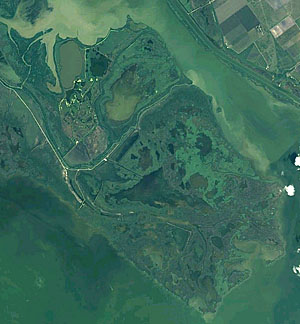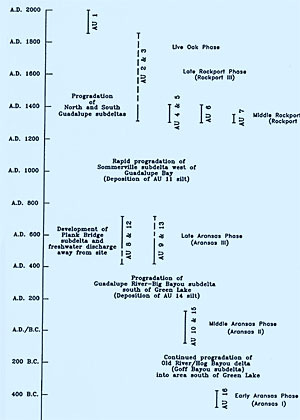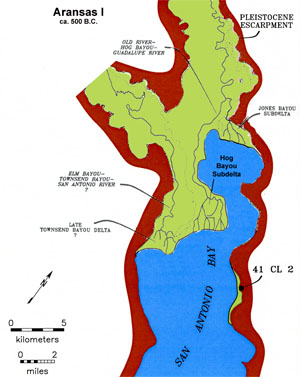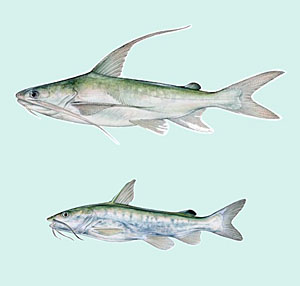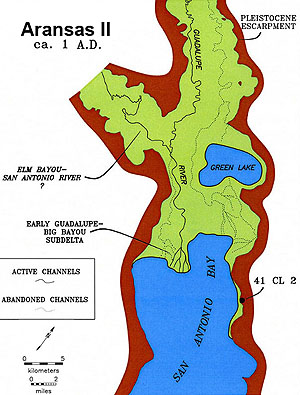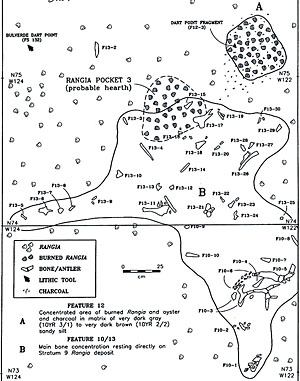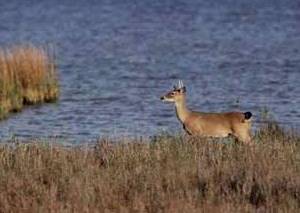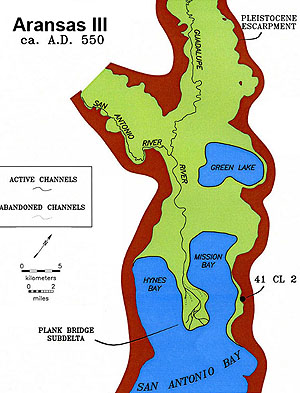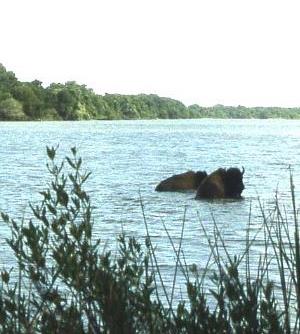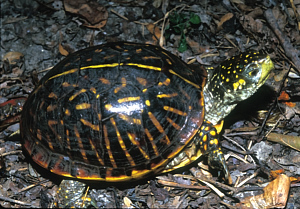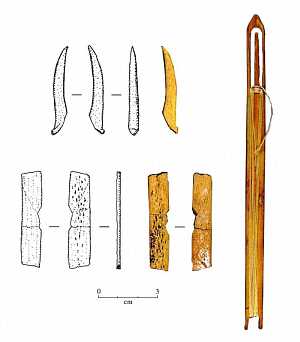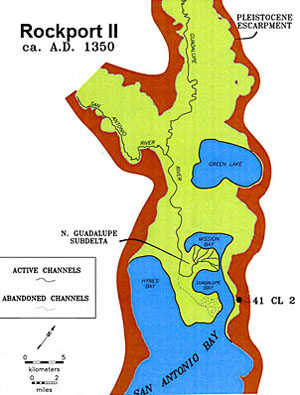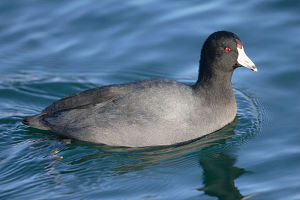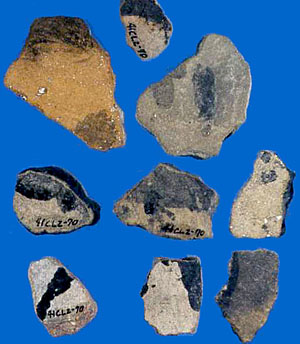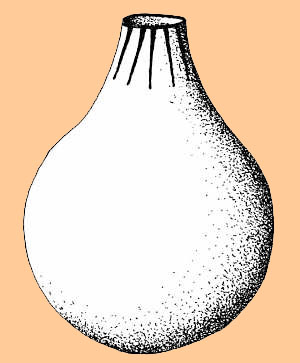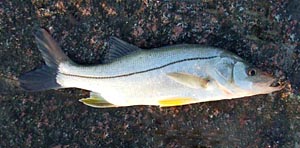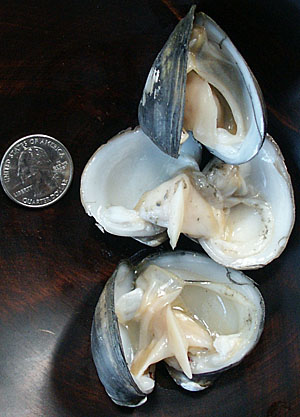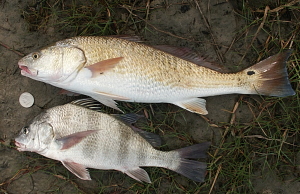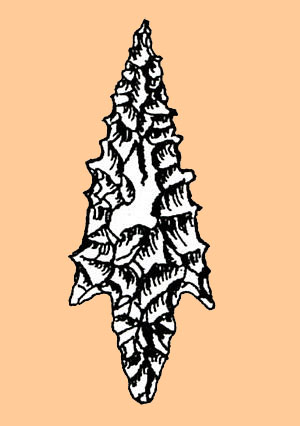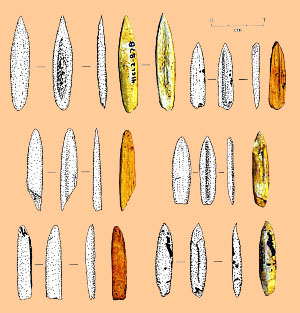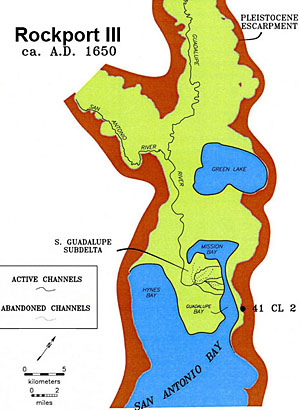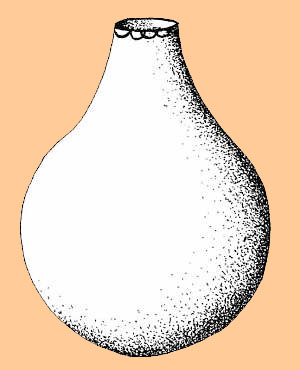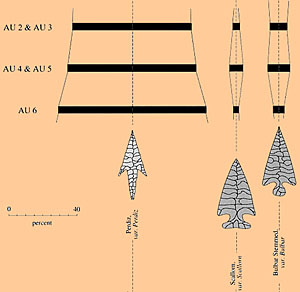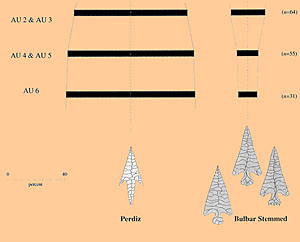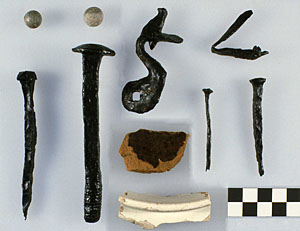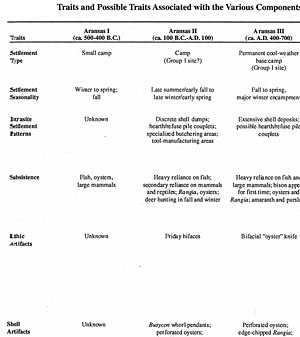Life at Guadalupe Bay
Life on Guadalupe Bay as depicted by artist Frank Weir. Enlarge to see full painting. |
|
The Guadalupe Bay site served as a base camp or shoreline village from about 2,500 years ago (500 B.C.) on and off until the early 1800s. All told, six occupational periods were identified that date to this span of time, and these were assigned archeological phase or subphase names for ease of discussion: Aransas I, Aransas II, Aransas III, Rockport II, Rockport III, and Live Oak. We attempt to link these phases to the analysis units (AUs) described in the Evidence section that are tied to specific strata uncovered during the 1989 and 1992 excavations. The contents of one or more of these AUs were used to document the material culture and subsistence patterns of each phase or subphase. Here we review each occupation and examine its place within the bigger picture of life along the lower Guadalupe River and around San Antonio Bay over the past 2,500 years. We draw upon archeological and geomorphological information available for the lowermost Guadalupe River and San Antonio Bay area. Natural Setting gives an overview of the changing geography of the lower Guadalupe, but here we go into a bit more detail to help explain the setting for each occupation. The reader, however, should bear in mind that these "paleogeographical" interpretative reconstructions are tentative best-guesses given the equivocal data at hand, especially for those related to the Late Archaic. These scenarios will be reconsidered by future researchers as more archeological and geological data are acquired. The model of the cultural ecology of the Karankawa Indians and their ancestors developed by Robert Ricklis was used to frame the research hypotheses evaluated by the results of the 1992 investigations at the Guadalupe Bay site. Ricklis argues that the Karankawa along the central Texas coast characteristically spent cooler months along the bays and moved inland during warmer months to take advantage of the resources found in the coastal prairies and stream valleys. In the fall-winter they congregated in groups of up to 300-500 people at favored "Group 1" encampments along the bay shores to exploit certain marine species of fish, particularly black drum and redfish, which spawn during the fall through winter. In spring they divided into smaller groups and went inland, camping along the prairie margins to hunt bison and whitetail deer and take advantage of various other resources. "Group 2" camps were more numerous and smaller in size, reflecting periods of higher mobility in search of less concentrated resources. With Ricklis' model in mind, we review the occupational history of the Guadalupe Bay site. Aransas I (ca. 500 B.C.)By 500 B.C. sea level was near its current height, having reached its modern elevation roughly 500 years earlier. As sea level began to stabilize, this caused the lower Guadalupe River valley to fill with sediment and allowed the river to begin building an impressive delta at the head of San Antonio Bay. The delta continued to “prograde” or build seaward for the next two thousand years. Around 2,500 years ago, the Guadalupe River is believed to have flowed down the eastern and central parts of the valley, a slight shift westward out of an earlier course that had hugged the eastern side of the valley. Green Lake began to form as newly amassed land from older and newer subdeltas started to envelope the area. A series of archeological sites in the delta and uppermost San Antonio Bay area seem to have Aransas I components, including the initial occupation at Guadalupe Bay (41CL2 ). This occupational spurt was likely a direct response to the development of a rich estuary as the prograding delta lowered salinity levels and created productive nursery areas teaming with shellfish, finned fish, and all manner of ducks, crabs, and other wildlife. Extensive shellfish beds formed, both within the brackish waters of the delta and in the saltier waters in the bay. Tellingly, the northernmost sites (north of Green Lake) contained midden deposits that were comprised of almost 100 percent rangia clams (Rangia cuneata), a brackish water species . In contrast, the shell deposits at Guadalupe Bay were made up predominantly (95 percent) of eastern oysters (Crassostrea virginica), which need higher salinity levels. Two sites in between contained mostly rangia (80 to 90 percent). These patterns suggest that sites just above and near the head of the bay were adjacent to relatively fresh water with salinity levels only marginally suitable for oyster growth. Whereas, the Guadalupe Bay site overlooked upper San Antonio Bay where waters were somewhat brackish, but salty enough that oyster beds flourished nearby. But what exactly do we know of the Aransas I component at Guadalupe Bay? This occupation was not well sampled by excavation. Small exposures of several deep oyster deposits were combined into Analysis Unit 16 for interpretation and presentation. While the data are limited, the oysters associated with the Aransas I component apparently were collected from a mixed mud-and-sand substrate, reflecting a low-salinity, estuarine environment relatively close to a source of sediment. Based on seasonality estimates from a small sample, they were acquired primarily during the winter and spring. Animal bones were poorly preserved, with only a few unidentified mammal bones recovered. However, a relatively large quantity of marine drum and catfish otoliths (inner ear bones) were identified. Interestingly, these otoliths came almost entirely from marine catfish four to nine years of age. The larger gafftop catfish outnumbered the smaller hardheads two to one. Today's coastal fishermen know that gafftop makes the superior table fare. Otoliths from drum and sea trout were completely lacking, although these fish contributed most of the otoliths recovered in all subsequent components at the site. Otolith seasonality estimates suggested that over 90 percent of the catfish died during the late winter or spring. It is surmised that a natural disaster, perhaps a sudden hard freeze, might account for the unique otolith assemblage. Male catfish are known to be present in estuaries during the spring as they incubate their young in their mouths. Perhaps a fish kill of some sort took place, whereby numerous mature catfish were washed ashore and collected by the Aransas I occupants of Guadalupe Bay. Alternatively, they may have targeted gafftop with effective fishing techniques. Unfortunately, no diagnostic artifacts came from the Aransas I deposits. Given available data, the Aransas I occupation seems to represent repeated visits to the site, mainly during the fall, winter, and spring months, probably by small groups of people who hunted, gathered, and fished the upper San Antonio Bay estuary. Aransas II (ca. 100 B.C. to A.D. 100)Although occupation at Guadalupe Bay apparently did not take place during the interval from ca. 400 to 100 B.C., other sites in the area were occupied and the Guadalupe River continued to extend itself into San Antonio Bay. Delta development isolated and fully enclose the northernmost part of the bay, thereby creating Green Lake. It is theorized that sometime shortly after 200 B.C. the Guadalupe River began to follow a new western route to the head of San Antonio Bay. Now within its modern meander belt, the Guadalupe River began to build the first of a series of subdelta lobes associated with the modern delta system—namely, the early Guadalupe River-Big Bayou subdelta. The Aransas II component at Guadalupe Bay was represented primarily by materials identified as Analysis Units 10 and 15. These “rangia” deposits actually consisted of about 75 percent rangia and 25 percent oysters, suggesting salinity still high enough to support limited oyster beds. As with the Aransas I deposits, the oysters all appear to have come from a mixed sand-and-mud substrate (as opposed to a hard reef), while the rangia were somewhat smaller than those recovered in later occupations, generally falling within the size range of three- and four-year-old clams. Snails from the component indicate a relatively wet and wooded environment, with nearby patches of open grasslands. Only a limited number of unequivocal Late Archaic artifacts came from the Aransas II deposits. Included were several large bone points from the AU15 deer butchering area (Feature 10/13), possibly indicating localized bone-tool manufacture; as well as several Friday bifaces, a Busycon pendant and several additional worked whorl fragments. Perforated oyster shells and modified rangia shells also were recovered. No perforated rangia came from the Aransas II deposits. Overall, the Aransas II component appears to have been based on site occupation from late summer through early spring, again probably by groups of people who fished, hunted large mammals, and collected shellfish from the nearby bay. It can be argued that the number of people present at the site at any one time was never particularly large. This scenario generally supports Ricklis’ hypothesis concerning the make-up and season of occupation of Group 1 sites. The basic midden refuse reflects a heavy reliance on fish coupled with a moderate use of shellfish, while the deer-butchering area indicates that large mammals often were an important part of the diet. Aransas III (ca. A.D. 400 to 700)Following the Aransas II occupation, there was a gap of about 300 years at Guadalupe Bay before the site was reoccupied during the Aransas III subphase. While there was no activity at Guadalupe Bay during this 300-year period, such was not the case at other sites in the area. This interval was marked primarily by the continued progradation of the Guadalupe-Big Bayou subdelta, eventually extending far enough to the south to create embryonic Mission and Hynes bays. By now the San Antonio River was probably entrenched in its modern channel, following the southern edge of its valley, meeting the Guadalupe River at its current confluence. These changes brought more freshwater and sediment into the waters near the Guadalupe Bay site, which may have adversely affected the local shellfish populations. This, in turn, may have led to the apparent occupational hiatus between the Aransas II and III occupations. By ca. A.D. 400 the Guadalupe River had created the Plank Bridge subdelta as an extension of the older Guadalupe-Big Bayou subdelta. With this development came a discharge of freshwater to the southwest, away from the location of the Guadalupe Bay site. Creation of the Plank Bridge subdelta also occurred during the peak of a possible late Holocene high-sea stand. Taken together, both the higher sea stand and river discharge to the southwest would have allowed for an increase in salinity levels near the site, and a growth of oyster beds in the vicinity. These beds provided an attractive and easily exploitable resource for the local Indians, and the Guadalupe Bay site was reoccupied around A.D. 400 to take advantage of their presence. The Aransas III component at Guadalupe Bay was marked by the extensive and dense oyster deposits of Stratum 3 in Block1 (AUs 8 and 9) and Stratum 7 in Block 3 (AUs 12 and 13). In both cases, oysters comprised about 95 percent of the shellfish present, with rangia making up the remaining five percent. Such a high percentage of oysters suggests that salinity levels near the site must have been higher than during the previous Aransas II occupation.This finding seems at odds with an increase in the frequency of freshwater fish taxa relative to saltwater species, as recognized by analysis of the vertebrate fauna.Nevertheless, these freshwater species may reflect fish taken in the streams and marshes of the newly extended delta, rather than an actual decrease in bay salinity. After all, it was during Aransas III times that freshwater delta habitats would have become available for the first time only a short distance to the west across Guadalupe Bay. All of the oysters were from non-reef communities that apparently had developed on a mixed-sand-and-mud substrate, while the few rangia present in the Aransas III component were fairly small, matching the size range of the Aransas II rangia. Interestingly, these represent the only two occupation periods where there is evidence of overexploitation of the local shellfish beds. Snails indicate a general continuation of the wet and wooded conditions similar to those present during Aransas II. Animal bones associated with Aransas III are particularly interesting. As noted, there still was a heavy reliance on fish, but large mammals comprised a significant part of the subsistence base, and bison were hunted for the first time, although only infrequently. There also was a relatively heavy reliance on reptiles, particularly turtles, more so than that recognized for any of the previous or succeeding components at the site. Although floral preservation was particularly poor at Guadalupe Bay, the Aransas III component was the only occupation to yield evidence of potentially edible species, as seeds of amaranth and purslane were recovered from AU 9. Indians of the southeastern United States are known to have eaten amaranth seeds, while the leaves of purslane are edible as well. Again, only a few artifacts could be confidently assigned to the Aransas III component. Lithic items included a possible chert “oyster” knife, a large bone point, two bone netting needles, and the bone barb off a composite fishhook. These clearly indicate that fishing technology had developed to a rather sophisticated degree. Shell tools included two edge-flaked Macrocallista shells, possibly used as knives, and numerous modified rangia and oyster shells. Many perforated oysters are assigned to the Aransas III component. Overall, the Aransas III component marks the first clear evidence of a relatively permanent, cool-weather base camp frequently visited during the fall, winter, and early spring months. Thus, the population may have been somewhat greater than that present during the Aransas I and II occupations, possibly approaching that of a true Group 1 village. However, this cool-weather Aransas III occupation did not subsist entirely on fish and shellfish. Rather, large mammals and reptiles also formed a significant part of the diet. Such diversification may have been brought about by the introduction of the bow and arrow among inland populations during the latter part of this time period. This may have allowed for more efficient territorial control by inland groups, thus restricting the hunting and gathering ranges of the coastal Indians. This, in turn, might have required the coastal groups to confine their activities to the area’s bays and estuaries, possibly residing at only a few sites for extended periods of time during the year. Rockport II (ca. A.D. 1300 to 1400)Archeological evidence suggests that Guadalupe Bay was mostly, if not entirely, abandoned for almost 600 years following the end of the Aransas III occupation. During this hiatus in site occupation the Guadalupe River delta continued to advance into San Antonio Bay and new subdeltas formed as others were abandoned. This geomorphological development resulted in changes in water flow and in localized salinity conditions. By A.D. 800 the Guadalupe River appears to have been sending significant amounts of freshwater and sediment into the bay immediately offshore from the Guadalupe Bay site, effectively eliminating local shellfish beds and probably causing people to camp elsewhere. Several sites in the region have provided evidence of occupation including expanding-stem Scallorn arrow points and possible pre-Rockport ceramics. The Guadalupe Bay site was not inhabited again until ca. A.D. 1300 at the onset of the Rockport II subphase (Rockport I is thought to date between ca. A.D. 1150 and 1250, but was not present at Guadalupe Bay). The paleogeographical reconstruction for ca. A.D. 1350 illustrates the study area at a time roughly in the middle of the Rockport II occupation. By then the Guadalupe River had a begun to build the North Guadalupe subdelta, depositing sediment and freshwater into Mission Bay by way of its main channel. This reduced the size of Mission Bay and almost closed the bay off from Guadalupe and San Antonio bays. Since the mouth of the river had moved away from the Guadalupe Bay site, shellfish beds in Guadalupe Bay were able to grow once more, and the site became a highly favorable place to live. In fact, this is inferred to have been the most-intense period of habitation at the locale. Other locations along the eastern margins of the Guadalupe River valley and San Antonio Bay also seem to have been favored for settlement during this time, including several with evidence of substantial Rockport occupations. These include the Traylor Ranch (41CL1) and Green Lake (41CL13) sites, both of which have yielded extensive quantities of Rockport ceramics and Perdiz arrow points. A number of aboriginal burials at the Green Lake site may represent a small cemetery for the local Rockport population. The Rockport II component at Guadalupe Bay included remains within the lower part of the Stratum 2 mixed rangia and oyster deposits found in all three excavation blocks (AUs 2, 3, 4, and 5), the Stratum 3 discrete rangia deposits of Block 3 (AU 6), and possibly the Stratum 5 discrete oyster deposits of Block 3 (AU 7). The upper strata included somelater Protohistoric and historic period artifacts. Accordingly, the various Rockport AUs were divided into “upper” and “lower” Rockport assemblages, with the latter (or “lower”) assemblage representing as “pure” a Rockport II component as could be isolated at the site. Aside from the AU 7 oysters, Rockport II shellfish associated with the lower Rockport deposits range from 50-80% rangia, by weight, with the remainder consisting of oysters. Clearly, the rangia were the primary shellfish gathered. These were somewhat larger than those found in the Aransas deposits, mainly four- to six-year-old clams, suggesting that the local environment was becoming more brackish and suitable to rangia growth. The oysters, on the other hand, show little change from the previous components, as all still were from non-reef communities with exceedingly low salinity values. The animal bones also highlight changes in the subsistence base. Although fish still were prevalent, and represent 38 percent by weight of the analyzed bone, there is greater diversity in both the size of the fish and the marine species present. Several warm-weather species, especially snook, suggest a lengthened occupation of the site that probably extended, at least on a limited basis, into the summer months. The finding of a marine turtle also suggests habitation during warm weather, as the turtle probably was captured while coming ashore to lay eggs during the early summer. Summer occupation further is indicated by some of the large-mammal remains, including deer killed over the course of several months between early June and the end of the year. Otolith seasonality data likewise indicate some occupation of the site during the summer, while the greatest percentage of summer oysters, from any of the components, came from the lower Rockport levels (16 percent). Nonetheless, the main occupation at the site still occurred during the fall through early spring months. Ducks and coots, plus deer taken in the fall, indicate cool-weather occupation. So, too, do does the otolith and oyster seasonality data, with upwards of 90% indicating fall to early spring harvest. There also seems to have been a greater reliance on very large mammals, reflecting an increase in bison hunting, probably indicating the occasional influx of bison herds onto the coastal prairies. Taken together, these data suggest that the Guadalupe Bay site served as a fairly permanent base camp or small “winter village” during the fall, winter, and early spring months, with sporadic site use during the summer. This latter occupation almost certainly consisted of fewer individuals than during the cool-weather months, although subsistence strategies remained the same: Fishing, hunting, and limited shellfish collecting. The year-round use of the site during Rockport II also is reflected by the quantity and diversity of associated artifacts. For the first time at Guadalupe Bay, there is a profusion of lithic, shell, bone, and ceramic artifacts. Along with these are indications that certain areas of the site served as special-activity loci, where selected tasks and/or ceremonies occurred. The Rockport II occupation yielded tens of thousands of pottery sherds, many of which seem to represent well-made vessels indicative of a well-developed and highly refined aboriginal ceramic tradition. Identified almost entirely by sherds of the types Rockport Plain, Rockport Black-on-gray, Rockport Black, and Rockport Incised, this “Rockport” ceramic tradition unquestionably represents vessels manufactured by prehistoric Karankawan Indians. The ceramics (and other artifacts) from the lower Rockport analysis units were thought to represent items related to the prehistoric Karankawans, while those of the upper Rockport analysis units included a mix of remains from prehistoric, protohistoric and historic Karankawan groups. As such, it was hoped that some chronological variation could be recognized, and this could be utilized in the future to help sort one Karankawan occupation from another. As discussed in the Pottery section, several suggestive trends in type and variety frequency were detected. It was found that the lower Rockport assemblage included slightly more sherds of Rockport Black-on-gray, Rockport Black, and Rockport Incised. It also contained more punctated specimens and more specimens with incised lips. Several of the identified varieties had slightly higher showings in lower Rockport, including Green Lake, Guadalupe, and Austwell, all suggestive of a greater use of bone, shell, and/or combinations of bone and shell as tempering agents. Several of the motifs recognized at the site occurred only in lower Rockport, although many were based on a very limited sample of sherds. Included were the “Aryes Point,” “Bendewald Point,” and “Foster Point” motifs of Rockport Incised, the “Copano Bay” and “Pats Bay” motifs of Rockport Black, and the “Rattlesnake Island” motif of Rockport Black-on-gray. The latter, however, is very similar to historic motifs found on sherds at Mission Espíritu Santo, so it may actually represent a much later form of decoration. Interestingly, the Block 3 area contained evidence of potential Rockport II ceremonialism and/or food consumption, as the area contained a higher percentage of painted fine-ware serving vessels, including relatively thin-walled bowls of Rockport Black and Rockport Black-on-gray. Tellingly, the Rockport II vessels at Guadalupe Bay had orifice diameters that matched quite closely the diameters of aboriginal vessels recovered from Missions Espíritu Santo and Rosario by Robert Ricklis. Taken together, these three sites had vessels that were somewhat larger than those recovered from the Oak Mott site, a small, short-term camp in Aransas County. These data suggest, that at larger sites with semi-permanent, year-round occupations, such as Guadalupe Bay, utilized larger vessels than those used at small short-term hunting or foraging sites. Several different types and varieties of arrow points were associated with the lower Rockport levels. Those with greater percentages in lower (versus upper) Rockport included: Perdiz; Scallorn, and Bulbar Stemmed, var. Bulbar. Their greater showing in lower Rockport suggests that they are fairly good indicators of a Rockport II occupation. Somewhat surprisingly, no other artifact classes showed a marked occurrence in lower Rockport. Guadalupe Bay also served as the locus for the manufacture of numerous shell tools and ornaments throughout the Rockport occupation. In Block 3 several Macrocallista and Busycon items associated with the hearth areas suggest these may have represented loci of shell-tool manufacture. Bone tools and ornaments also were well represented in lower Rockport, including bird-bone and shark-vertebrae beads. The diagnostic “small” bone point was particularly prevalent. Also found in lower Rockport were a possible netting-needle midshaft fragment, a large point similar to those from the Aransas deposits, and a large bone point preform. The latter two items suggest a possible continuity of Late Archaic point-manufacturing techniques into Late Prehistoric times, although their association with the Rockport occupation is questionable. Overall, the Rockport II occupation at Guadalupe Bay probably consisted of intense use of the site during the fall, winter, and early spring months, with sporadic occupation continuing throughout the summer months. Although the population never was very large at any one time, it is likely that several family groups were present during the cool-weather months, and that the site served as a base camp or small winter village. Seen in terms of Ricklis’ Karankawa settlement mode, it is likely that the site functioned as a small Group 1 winter village for most of the Rockport II occupation, although it may also have served as a Group 2 summer encampment. As hypothesized by Ricklis, fish and shellfish were the primary resources taken during the cool-weather occupation, with large mammals, such as deer and bison, forming a significant part of the diet. Fishing and possible shellfish collecting continued throughout the summer months, indicating that the minor Group 2 occupation partook of many of the coastal resources available during the warmer time of the year. Rockport III (ca. A.D. 1500 to 1700)In contrast to all previously discussed occupational periods, the Guadalupe Bay site is the only site known in the Guadalupe River delta area that has evidence of protohistoric occupation. It is likely that the Guadalupe River had begun to build a new subdelta during this interval, identified as the South Guadalupe subdelta, just to the south of the previous North Guadalupe subdelta. Although some discharge still continued down the latter, the former bore the main thrust of the river’s flow and sediment and freshwater entered the upper reaches of Guadalupe Bay. Areas that previously had been open water began to fill in with marshes, probably a detrimental effect on the local shellfish populations. This may explain, in part, the dearth of protohistoric sites in the vicinity of Guadalupe Bay. Although a Rockport III occupation certainly was present at Guadalupe Bay, it is extremely difficult to recognize archeologically. Only very subtle changes in artifact frequencies between the lower and upper Rockport levels, along with the possible introduction of a few new artifact forms, can be used to potentially pinpoint the component. Unfortunately, the Rockport III remains are masked by the much greater quantity of Rockport II items still prevalent in the upper Rockport levels. This admixture seems to reflect a stable land surface affected by bioturbation from tree roots, burrowing animals, and human activities, both during and after the aboriginal occupation of the site. It is estimated that the Rockport III component at Guadalupe Bay occurred between ca .A.D. 1550 and 1700. As noted earlier, the lower end of the Guadalupe River is thought to have shifted slightly to the south sending freshwater and sediment into the upper reaches of Guadalupe Bay, possibly affecting the local shellfish beds near the site. Such an effect is difficult to identify, however, as the upper Rockport deposits still contained a significant quantity of both rangia and oysters. Snail data from the upper Rockport levels mirror those of lower Rockport. The environment continued to be relatively dry with nearby areas of open grassland. It can be surmised that conditions were similar to those present at the site today. Animal bones associated with the upper Rockport are interesting. Although the general patterns recognized for lower Rockport remain the same, there are differences worth noting. For example, upper Rockport had comparatively more very large mammals (e.g., bison or possibly even wild Spanish cattle) and large mammals (e.g., deer) and less fish (26 percent) than lower Rockport, suggesting a greater reliance on hunting and less effort spent in fishing. This may be related to the greater availability of bison known from early historic accounts. The upper Rockport also contained beaver and otter, species not present in lower Rockport. These also may reflect greater emphasis on hunting of small mammals during Rockport III, although they could represent animals taken during the succeeding Live Oak occupation for use in fur trading. Seasonality data suggested a similar occupational story as that represented by the lower Rockport fauna, although summer may have been somewhat less favored. Although it is not possible to determine exactly how these inferences actually relate to the Rockport III component, as opposed to the intermixed Rockport II component, the overall impression is that occupation at Guadalupe Bay during Rockport III would have been very similar to that during Rockport II, with the exception that there probably was less time spent at the site during the summer months. Ceramic indicators of the Rockport III occupation are difficult to identify with any confidence. Some potential chronological trends can be suggested. In contrast to the ceramics from the lower Rockport levels, those from the upper Rockport levels contained slightly more plain sherds and more sherds with notched lips. There was also a definite association of Rockport Red with upper Rockport, suggesting that this type may be a very good protohistoric and/or historic marker. Bottles seem to be associated with upper Rockport and may be fairly late in the Rockport sequence. The “Espíritu Santo Bay” and “Shoalwater Bay” motifs of Rockport Black only occurred in upper Rockport, while the “Carancahua Bay motif” had its greatest showing in the upper Rockport levels. Likewise, the “Steamboat Island” and “Turnstake Island” motifs of Rockport Black-on-gray had higher percentages in upper Rockport. The “Rattlesnake Island motif” may also be fairly late, as it resembles designs found on ceramics from Mission Espíritu Santo. Arrow point types found only in upper Rockport included Cuney, Lozenge, Guerrero, and Fresno, and the Calhoun variety of Bulbar Stemmed. All may represent either Rockport III or Live Oak items. Other Bulbar Stemmed varieties, save var. Bulbar, also exhibited increased frequencies in upper Rockport, suggesting greater use during Rockport III and/or Live Oak times. Additional lithics with somewhat higher frequencies in upper Rockport included scrapers, perforators, bifacial knives, and edge-modified flakes. As with the lithic tools, most of the modified shell categories found in lower Rockport also occurred in upper Rockport, but in slightly greater amounts. Only Oliva and Olivella beads and tinklers were more common in lower Rockport. Lastly, bone tools and ornaments from the upper Rockport levels also matched those found in lower Rockport. Unlike the lithic and shell artifacts, however, bone tools were less common in upper Rockport than lower Rockport, suggesting that the manufacture of such items may have been in decline during Rockport III times. This is particularly interesting if the small bone points were related to the fishing industry (either as the pointed tips of leisters or as gorges). Their decline mirrors the apparent decrease in fishing activities from Rockport II to Rockport III. Live Oak (ca. A.D. 1700 to 1830)By the late 1700s, the Guadalupe River delta had, for all intents and purposes, reached its modern configuration. A landscape similar to that of today almost certainly existed, minus, of course, the barge canal and other historic modifications. Three sites with historic components, and a possible fourth, are known for the study area. All can be identified by the presence of very late arrow point types, late-looking aboriginal ceramics, and late-eighteenth-century European artifacts. These sites, including Guadalupe Bay, may be related, in one way or anther, to the Spanish mission of Nuestra Señora de Refugio, which was situated in at least three different locations near the mouth of the Guadalupe River between 1791 and 1795. While it is unfortunate that none of the mission locations have been definitively identified, the missions would have been within a few hours walk, at most, from the Guadalupe Bay site. The site yielded Guerrero and Bulbar Stemmed arrow points, Rockport ceramics with late decorative motifs, and several European artifacts. Cuney, Lozenge, Fresno, and Bulbar Stemmed, var. Calhoun arrows, plus a sherd with a loop handle, also may be part of the Live Oak assemblage. Although not one of the major occupations at the site, the Live Oak component clearly is real and recognizable. Despite its rather ephemeral nature, the Live Oak component at Guadalupe Bay is easier to identify than the previous Rockport III component. This mainly is due to the presence of several eighteenth-century European artifacts and a few aboriginal items known from historic contexts elsewhere in Texas. Generally, this material also came from Stratum1 (AU1) and/or the upper part of Stratum 2 (AUs 2 and 3). European ceramics believed indicative of the Live Oak occupation consisted of five sherds of coarse earthenware (including one redware sherd and one with a reddish-yellow paste that may be of French origin), a sherd of late or transitional creamware, and a sherd of pearlware. In addition, earlier collections from the site included a lead-glazed redware sherd, a blue-edged pearlware sherd, and a sherd from a Spanish olive jar. Also present were a single seed bead, colored robin’s egg blue, almost certainly dating to the eighteenth century, as do a longarm flintlock hammer and a flintlock sear spring. Although these items may well have been used by the Live Oak aboriginal inhabitants of the site, it is also possible that later Euro/American settlers discarded them. Other intriguingly early metal items that could be associated with either a final 18th-century native occupation or 19th-century Euro/American settlement include five black-powder ball shots, five hand-wrought nails and 21 machine-cut and hand-headed nails. Interestingly, 23 of these 26 nails came from Block 3, suggesting that that area may have been the locus of an aboriginal structure, or that the Live Oak occupants used the nails as gravers, perforators, etc., to help manufacture and/or decorate aboriginal artifacts. One hand-wrought and hand-threaded bolt also was recovered, and it most likely can be tied to the Live Oak component. Aboriginal artifacts are more difficult to tie to the Live Oak occupation. Probably the only item that can be confidently associated is the Guerrero arrow point mentioned earlier in the discussion on Rockport III. Other possible Live Oak items are the Lozenge, Cuney, and Fresno points, and the Calhoun variety of the Bulbar Stemmed type. These artifact types were also found at the Shanklin site in Fort Bend County, where they almost certainly date to the eighteenth century. While many of the aboriginal sherds found in the upper Rockport deposits could date to Live Oak times, there is no way of sorting these from those of the earlier Rockport II and III components. Summarizing the Live Oak component, the Guadalupe Bay site was almost certainly used by historic Karankawa groups ancestors, but cultural details or inferences beyond those noted above cannot be drawn. About all that can be said is that the Indians had access to a few European artifacts. How they acquired these items is open to speculation. They may have obtained them through trade with other Indians or with the occupants at Mission Refugio in the 1790s. They may have scavenged them from shipwrecks in the area, or they may have pillaged them from Mission Refugio after it was abandoned. Whatever the case, these items mark the final aboriginal occupation associated with the Guadalupe Bay site. |
|
